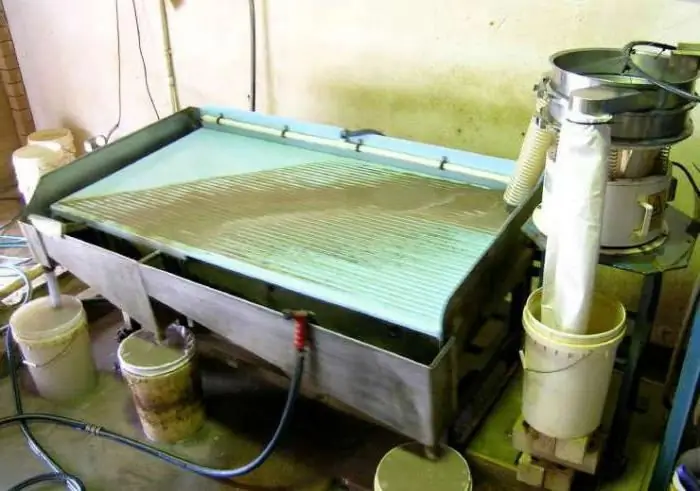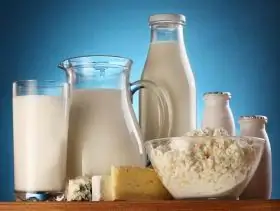2025 Author: Howard Calhoun | [email protected]. Last modified: 2025-06-01 07:12:56
Milk purification and filtration processes are designed to remove contaminants and natural unwanted impurities from its composition. There are different ways to solve such problems, differing in technological organization, efficiency, productivity and performance. The equipment for milk purification, which is equipped with production lines, also differs.
General cleaning technology
All processing operations are carried out in special conditions that meet technical and sanitary requirements. The standards applied to the organization of the work of food enterprises are taken as a basis. On dairy farms, both separate technological processes for processing raw materials and complex preparation of the product can be carried out.
The main cleaning methods today are implemented on milk separators and centrifuges with pasteurizers. At a minimum, this equipment allows the removal of milk plasma mucus, mechanical impurities and dirt particles. Finer filtering also has an effectdisinfection to kill harmful bacteria. Methods for purifying milk through thermal and biological effects are also being developed. In such processing systems, the physicochemical properties of milk are modified, the content of surfactants (proteins, phospholipids, fat globules and acids) is optimized and the surface tension is reduced.

Delivery of raw milk to production
The movement of milk between departments on the farm or its delivery by transport to the processing plant is carried out in special containers or tanks with refrigerators. According to the requirements, the inner surfaces of containers and reservoirs must be made of stainless steel or aluminum. External surfaces are finished with heat-insulating material. During the transfer process, it is important to maintain the optimal temperature regime of raw milk. So, the average temperature is 4-6 °C. In this state, the raw material can be kept for no more than 10 hours. If longer transportation is planned, then a special milk cooler is initially activated - equipment in the form of a tank, which immediately after milking lowers the temperature of the liquid product from 35 to 4 °C. At the same time, pathogenic elements of the composition are removed and useful qualities are preserved.
Cooling modes

Properties of milk, and in particular its bacteriological characteristics, will largely depend on the temperature of its further storage. If the product is left unrefrigerated,then after 10 hours of maintenance, its acidity will increase by almost 3 times, and at the same time the number of unwanted bacteria will increase sharply. For optimal storage in terms of favorable microflora, long-term maintenance in production requires maintaining a regime of 12 ° C. Strong cooling is also not recommended, since it is also detrimental to beneficial microorganisms. Again, a milk cooler with control sensors and an automatic temperature control system comes to the rescue, which takes into account several physical and chemical properties of milk at once. Such equipment can contain from 100 to 1000 liters at the same time, depending on the model and production needs. The choice of specific cooling tactics will depend on the holding time, but short periods at different stages of milk cleaning and processing usually require maintaining 4-6 ºС.
Main Machining

This process can also be called centrifugal separation - this is one of the basic cleaning procedures, involving the separation of milk into fractions of different densities. For example, skimmed and high-fat milk (cream) can be separated. Technically, the process is organized at the capacity of a separator with a rotating drum. The operator of the installation during its operation monitors the following parameters of mechanical milk purification:
- Drum rotation speed.
- Fat globule release speed.
- Fat and plasma density.
- Viscosity.
As the density of milk plasma and fat globules increasesthe rate of separation and separation of the creamy mass is accelerated. In turn, an increase in viscosity contributes to a decrease in the rate of separation of fat fractions. The process of centrifugal milk purification is indirectly affected by the temperature and acidity of milk. Acidity can change the protein mass of milk by increasing its colloidal state. As a result, the process of flaking will begin against the background of an increase in viscosity and difficulty in separation. As for the temperature effect, its increase reduces the level of viscosity and slows down the process of transition of the fatty thick mass into a liquid state. Therefore, before separation, it is recommended to heat the milk to 35-45 °C. Increasing the temperature will also provide a more efficient degreasing process.
Milk separators

The above operations for the separation of milk fractions and purification are performed on special separators. As a rule, these are electric machines with a built-in motor, a collector, a bowl for loading milk and a centrifuge. On medium-sized farms, devices with a capacity of up to 50-70 l / h are widely used. At the same time, the drum rotation speed can reach 12,000 rpm. Modern equipment for dairy production has means of automated control and protection. Control and management is realized through a combination of sensors and a controller with a working operator panel. By setting the desired program, the user starts the separation process with robotic control in accordance with the established processing algorithmsmilk. Protective systems are mainly represented by devices that prevent electrical and thermal overloads.
Milk filtering
Also one of the initial processes of preparing raw milk for biological and chemical treatment. The main task at this stage is to remove contaminants that have fallen during milking or storage by filtration. The filters themselves may have a different device. So, closed-type membranes rid the liquid of large mechanical impurities. Usually such filters are installed on the lines of the production milk pipeline and milking systems. The quality and degree of cleaning depth will depend on the characteristics of the material used. The most effective filter for fine purification of milk, made of non-woven fabric. Sometimes several filter devices are used in one circulating circuit or in a milking installation to trap particles of different fractions.

Bactericidal cleaning phase
This is the time period during which microorganisms that have entered the milk do not multiply, but die. In this phase, the raw product is characterized by the presence of natural bactericidal properties provided by antibacterial substances. These include leukocytes, normal antibodies, lysozymes, etc. This ability of milk will depend on the physiological state of the cattle from which it was obtained. The duration of bactericidal milk purification is determined by the external microflora and storage temperature, but usually does not exceed 2-3 hours. In the future, it will be important not so much cleaning assuch as technological processes to maintain the life of antibacterial substances. The main measures of this kind include primary cooling, and filtration, as well as the introduction of enzymes that fight toxins that cause milk defects.

Technology for thermal treatment of milk
Heat treatment is used to disinfect raw milk. In the process of its implementation, not only the destruction of microorganisms with their metabolic products takes place, but also favorable conditions are created for maintaining and preserving the beneficial properties of milk. At the same time, it should be noted that the temperature effect itself in any form destroys the primary physical and chemical structure of the raw material. The degree of change will depend on the duration and temperature of the treatment. On dairy farms, this operation is performed by special heaters of tubular, capacitive and plate types. The multi-functional heat treatment equipment also includes a pasteurization bath design.
Conclusion

The efficiency of preparing raw milk for further processing is largely determined by its initial state. Not every raw material is, in principle, suitable for use in the food industry. There are special standards and requirements that determine the suitability of the product for harvesting. After a control check of physical, chemical and biological parameters, milk purification begins according to the previously prescribed scheme. These can be separate operations of chemical treatment with filtration, and deep comprehensive separation with the improvement of the bacterial microflora of the product. The specific set of cleaning operations will depend on the tasks of harvesting the dairy product on the farm or production line.
Recommended:
Sandblasting. Sandblasting and cleaning equipment

The article is devoted to the technology of sandblasting. The equipment for sandblasting and cleaning, as well as the features of its application are considered
Mineral enrichment: basic methods, technologies and equipment

The article is devoted to the technology of mineral processing. The stages and methods for performing such processing are described
How to open a cleaning company from scratch. Cleaning service. What does a cleaning company do

Relatively recently, a rather new line of business appeared in Russia, which has been dynamically developing in the West for more than a decade and has received recognition from numerous customers. These are companies that provide cleaning services
What is milk made of? How is milk powder made?

Surely everyone is concerned about the question of what milk is made of. In this article we will try to find answers to it and learn a lot about this product familiar from childhood
Welding of copper and its alloys: methods, technologies and equipment

Copper and its alloys are used in various sectors of the economy. This metal is in demand due to its physicochemical properties, which also complicate the processing of its structure. In particular, the welding of copper requires the creation of special conditions, although the process is based on fairly common thermal treatment technologies

